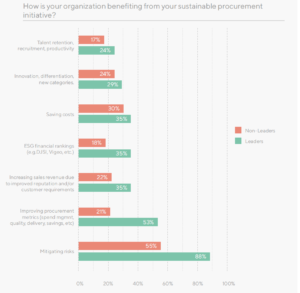Data from this year’s Sustainable Procurement Barometer shows there’s a clear ROI for moving along the sustainable procurement maturity curve.
Sustainable procurement leaders – companies that met a range of criteria signifying maturity of their sustainable procurement programs — realized markedly more business benefits than non-leaders, specifically in risk mitigation (88 vs. 55 percent), cost savings (35 vs. 30 percent), improved procurement metrics (53 vs. 22 percent) and innovation (29 vs. 25 percent). Also, 35 percent of those in this year’s “leaders” category said revenue growth for sustainable offerings was greater than the rest of their business, compared to 18 percent of the general population.

There’s a clear correlation: Companies with mature practices – including using supplier sustainability performance to guide strategy decisions, integrating sustainability measures into a balanced scorecard approach, setting clear targets and goals for both suppliers and buyers and more — realize greater returns. The common thread across all successful programs when it comes to speeding an organization’s path to business value is through finding the right mix of tools and activities to successfully engage suppliers in sustainability. Getting up and downstream partners to consistently and collaboratively improve performance across key sustainable procurement criteria is critical for not only getting sustainable procurement initiatives off the ground, but also driving real, long-term improvements.
39 percent of all companies surveyed struggle with tracking supplier performance, which is foundational for benchmarking progress and motivating suppliers to be more responsible, which given the various tools on the market today, could mean many companies aren’t looking at the bigger picture and are stuck in a compliance trap.

So what are leading procurement organizations doing more of – or differently – that enables them to create urgency and give suppliers a reason to start their sustainable procurement journeys? Here are a few observations from the study around the variety of methods used today to drive greater levels of performance.
Use of Tools & Incentives: Methods Used to Drive Engagement
When comparing the tools used by leaders vs. non-leaders, a huge disparity becomes clear in the use of external databases and scorecards. Over three times as many leaders (76 percent) do this compared to non-leaders (20 percent). Corrective action plans are also used almost 2.5 times more by leaders (82 percent) than non-leaders (34 percent). Similarly, category and country risk evaluation models are used significantly more by the leaders in the cohort (65 vs. 36 percent), which helps them prioritize which suppliers to engage with so they can focus and invest more time in relationships that are at higher risk of sustainability issues. The fact that leaders are successfully implementing these policies and tools show how critical they all are for driving higher levels of sustainable procurement performance.

Encouragingly, 43 percent of suppliers surveyed said sustainability is already part of their mission and they actively participate in sustainable procurement programs to improve the world and their communities. And the commitment is reciprocated on the buyer side: 49 percent of suppliers feel their buyers are committed to sustainable supply chain practices and actively partner to foster better practices in commercial relationships.
Overall two-thirds (62 percent) of suppliers say they feel somewhat or very incentivized by their buyers to be more sustainable apart from complying with existing regulations or codes of conduct. Many buying organizations (35 percent) use contract terms to motivate supplier sustainability, with collaborating on sustainable improvement strategies the second most popular tactic at 22 percent. Other incentive methods used include on-site audits (15 percent), sustainability performance targets (10 percent), and education around sustainable practices (8 percent).
Key Takeaways for Supplier Engagement
While documentation of program commitments is important, those looking to drive higher levels of supplier engagement shouldn’t stop there. Show suppliers that commitment extends beyond just "what’s on paper" through agreeing on mutual goals and key performance indicators, sharing best practices and collaborating on corrective action plans. Communicating that you’re in this together and willing to actively work together to achieve progress is much more motivating for a business partner when considering whether to take on a new initiative or inherently change their processes. Also, connecting sustainable procurement objectives back to the business side, and showing suppliers the tangible value that can be created for all parties when sustainable procurement programs are successful — revenue uplift, cost savings, ability to innovate and mitigate critical risks — is huge. This conversation will drive more urgency for suppliers that need a push to start implementing more responsible practices.
Insights on ROI, incentives, characteristics of sustainable procurement leaders and more can be found in our 2019 Sustainable Procurement Barometer: Download the full report here.
Looking for a quick and easy way to determine how mature your procurement organization is? Check out our diagnostic.













